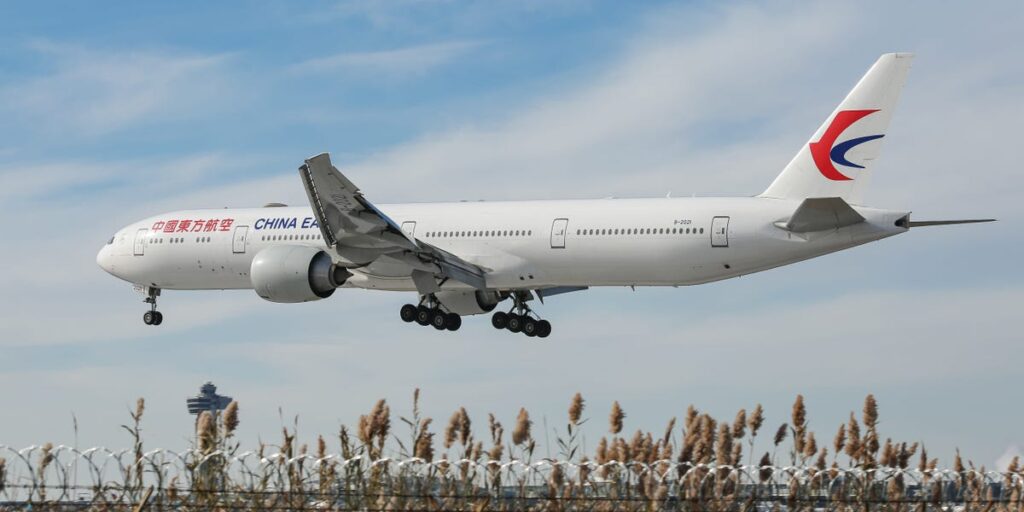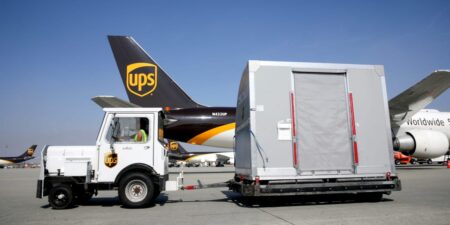A Department of Transportation order issued on Thursday aims to prohibit Chinese airlines from flying over Russia on US routes. Instead, these carriers would be forced to fly longer, less efficient paths — possibly adding multiple hours of extra flight time.
The order targets seven airlines, including Air China, Beijing Capital Airlines, China Eastern Airlines, China Southern Airlines, Hainan Airlines, Sichuan Airlines, and Xiamen Airlines. Hong Kong-based Cathay Pacific Airways was not named.
The DoT said barring Chinese airlines from flying over Russia would address a “competitive disparity” for US carriers; it excluded cargo carriers from the order. The agency added that Chinese airlines enjoy an “unequal” advantage by avoiding the added time and fuel costs of detouring around Russian airspace.
US airlines, such as American, Delta, and United, must fly less economical flight paths as they are barred from using Russian airspace amid sanctions over the nation’s invasion of Ukraine. It also strains maintenance, aircraft utilization, and crew rest.
United declined to comment. American and Delta referred Business Insider to their trade group, Airlines for America, which also represents United. “This is an important step that will help ensure U.S. airlines can compete with Chinese carriers on a level playing field,” A4A said in an earlier press statement. China’s embassy in Washington, DC, did not immediately respond to a request for comment.
The move comes amid escalating economic tensions between China and the Trump administration.
Foreign Ministry Spokesperson Guo Jiakun told Reuters on Friday that “barring Chinese airlines from flying over Russia on flights to and from the US would hinder travel and people-to-people exchanges.”
He added that the US should take “a hard look at its own policy and the impact on American businesses” instead of “punishing other countries and passengers around the world.”
The DoT wants to even the playing field
Flight tracking website Flightaware shows that only two of the potentially affected routes used Russian airspace in October.
This includes China Eastern’s flight between New York-JFK and Shanghai, as well as China Southern’s flight between New York-JFK and Guangzhou.
The two routes are about 15 and 16 hours nonstop, respectively. However, being forced to skirt Russian borders, should the order take effect, could add hours of flight time.
Finnair, for example, has flown four hours longer between Helsinki and Tokyo since Russia closed its airspace to most European carriers. British Airways is adding up to an extra hour to its flights between London and New Delhi.
Other US-China routes, such as Hainan’s flight between Seattle and Chongqing, Xiamen’s flight between New York and Fuzhou, and Air China’s flight between Washington, DC, and Beijing, all avoid Russia, according to Flightaware data for October.
US airlines have long complained about China’s flying
The US Big 3 airlines have long expressed frustration with the Biden-era decision in 2024 to allow Chinese carriers to operate up to 50 weekly roundtrip flights to the US — up from 35 and matching the number allowed for US airlines.
The Big 3 had urged the DoT not to approve the additional flights unless the Chinese airlines avoided Russian airspace. That followed a 2023 agreement in which the US allowed some new Chinese routes on the condition that they did not overfly Russia.
The flights aren’t always cheap, given the few options. Round-trip fares range from about $900 from Seattle to Shanghai in mid-November on Delta, to between $1,200 and $1,500 from Los Angeles, depending on the carrier. The nonstop flight from New York to Guangzhou on China Southern is nearly $2,000.
While Chinese carriers got more flying, US carriers have had to ax some China routes.
Data from aviation analytics company Cirium shows that United, for example, has not resumed flights to China from Chicago, Washington, D.C., and Newark, New Jersey, since the pandemic, but it operates from the West Coast.
Delta still isn’t operating its flight from Atlanta to Shanghai, although it does fly there from Detroit and Seattle.
Despite last year’s increase, flights between the US and China are still recovering from the pandemic. Cirium shows there are about 10,000 flights scheduled between the two nations in 2025 across both US and Chinese airlines. That’s down 28% from about 35,500 flights in 2019.
Security concerns of flying over Russia
Beyond economic concerns, there are security implications regarding US-bound flights over Russia. In June 2023 and July 2024, two separate San Francisco-bound Air India flights likely carrying Americans had to divert to Russia due to a technical issue.
There was concern that geopolitical tensions could threaten any onboard US citizens, though none were detained, and a relief plane was sent to rescue the stranded passengers.
However, United CEO Scott Kirby raised questions about allowing foreign airlines to continue flying over Russia on US routes.
“What’s going to happen if an airline lands in Russia with some prominent US citizens on board? That is a potential crisis in the making,” he said after the 2023 event.
It’s not uncommon for leaders to block flight paths through their nation due to economic tensions or war. The US and Russia have reciprocally blocked their airspace from each other’s home carriers since 2022.
Airspaces across the Middle East were closed in June and July due to heightened tensions between Iran and Israel.
Meanwhile, Pakistan closed its airspace to Indian airlines in April amid rising tensions in the area, and India responded with its own closure to Pakistani aircraft soon after.
Those airspace bans have been extended until at least late October, forcing carriers like Air India to spend extra time and money flying to cities in Europe, North America, Central Asia, and the Middle East. It even suspended its route between New Delhi and Washington, DC in September.
Read the full article here
















